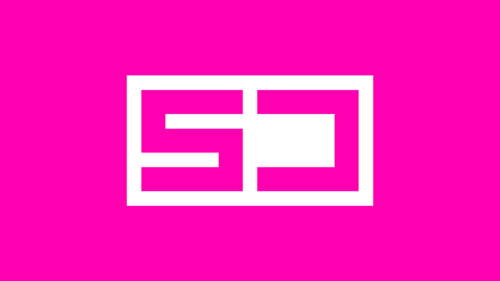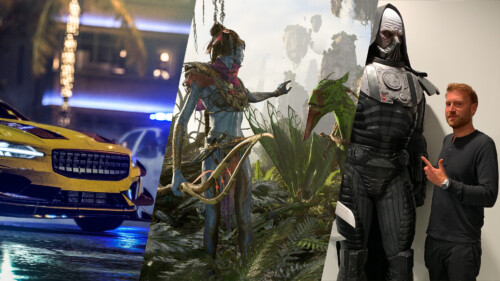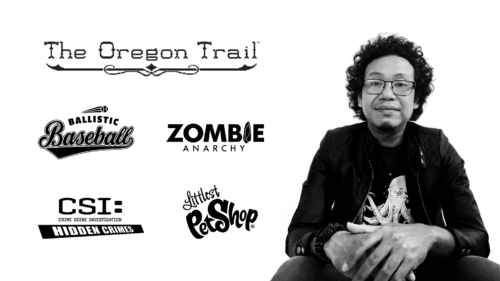Interview with Daniel Lucchesi
Presentation Director at Ubisoft Québec
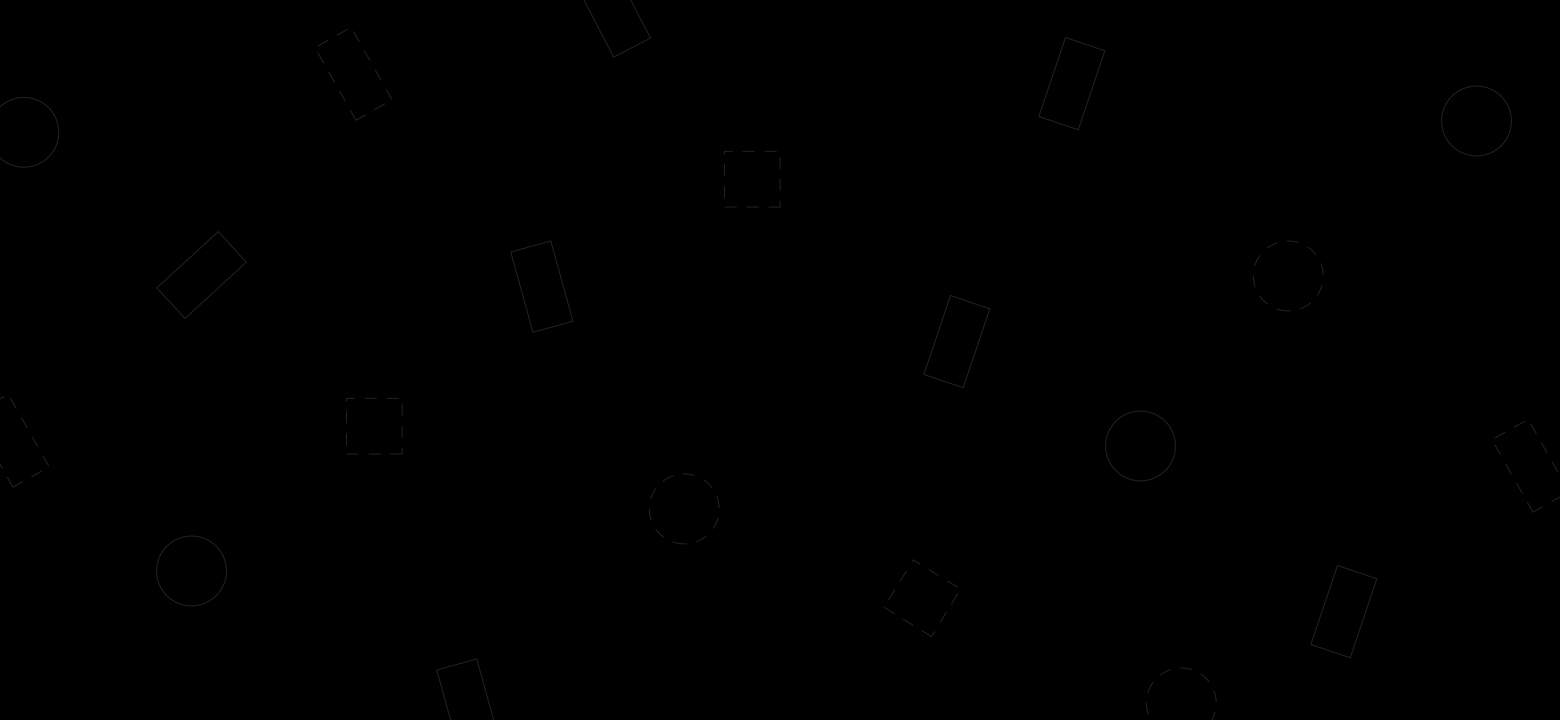

Can you introduce yourself in a few lines, what do you do and where do you work?
Bonjour! My name is Daniel Lucchesi and I am a French-Canadian videogame artist living in beautiful Quebec City, Canada. I currently work as a Presentation Director at Ubisoft Québec, where I have been evolving the last 14 years!
How did you start in the industry?
So first of all, I guess I should mention that I was born with a controller in my hand. Ever since my dad got us a Sega Master System for Christmas when I was five, I have always been playing games. Even today, with two kids and a lot of hobbies, I try and squeeze in as much gaming as I can in my free time.
Along with games, creativity is another thing that’s always been by my side. As early as high school, I was in an art-focused program (less maths, more drawing, everybody benefits!). I then followed with a ‘New Media’ program in college where we were introduced to photography, technical drawing and 3D modeling software. Then came the big moment where I had to choose a career. I knew from the start I wanted to stay in my home city, and at the time, local video game studios were very scarce so I decided to pursue Graphic Design in university, which sounded like a great compromise; I wouldn’t be creating games, but I’d design logos and websites. Cool! In my last year of the program however, luck got on my side as Ubisoft opened a new studio downtown, literally 10 minutes from my place. I immediately decided I was going to finish the school year, then shift my portfolio towards getting a job there as a UI Artist.
Back then (ok, now I sound old), there weren’t as many resources on how to build a portfolio and social media was still in its first baby steps, so getting an idea of the inner workings of the video game industry and how to get in was very intimidating. As I browsed the openings on Ubisoft’s website, there wasn’t anything UI-related, but they were looking for QA testers – that was my way in.
QA was an incredible opportunity for me. By interacting daily with all the departments involved in development, I started to understand everyone’s role and the different technical steps required to make a functional (and fun) game. Seeing more than a hundred individuals coming together towards a collective goal taught me how complex delivering a game is, and it really sealed my dream of making this my career.
After a few weeks at the office, the art manager noticed my interest in Graphic Design which opened the door for me to show my portfolio and explain to them how thrilled I’d be to join the UI team one day. Turns out that day came a lot faster than I expected: I started the following Monday as a UI Artist. Over the years, my responsibilities evolved as I slowly transitioned into a Presentation Director role, but one thing has always remained: my love for carefully crafted interfaces.
What are your responsibilities at Ubisoft Québec?
Presentation Director is a fairly vague title for anyone who’s not at Ubisoft so I’ll clarify that first. Presentation stands for visual identity, in and out of game, which includes not only the user interface, but also the whole branding of the product (logo, packaging, websites, promotional material, and such). As for my responsibilities, they vary greatly depending on the phase of development we are in. Let’s break it down into 3 stages:
Stage 1: Conception. My initial objective is to set the tone for the visual design art direction by assembling references and creating mood boards that will help me sell my vision to the core team and key stakeholders. At this point, my day-to-day is punctuated by a lot of creative brainstorm sessions and meetings (don’t we all love meetings?) among directors where we aim to identify the key ingredients of our recipe.
We then hit Stage 2: Pre-Production. This is hands down my favorite moment in a project. With a few members of the UI team that have joined at this point, we delve into spending a lot of time defining how stuff looks, how it moves, how it sounds. While designers and programmers are hard at work in the game engine developing several prototypes, I spend most of my time producing high-fidelity visual benchmarks in order to fill in one of our team’s cornerstone documents: The Presentation Styleguide. This half-UI, half-branding bible covers the whole visual identity for the game and provides general guidelines regarding graphic design, layout, iconography, typography, color palette, animation and more. While this giant compendium is being crafted, we also start dressing the list of components we’re going to need to create for the game such as menu pages, interface elements and even marketing assets. From there, we can start laying down our schedule and plan for the months ahead.
Finally, Stage 3: Production. This is when I start dropping the pen and gradually shift my focus towards review and supervision. By that time, we jokingly live by one motto: “if it’s not in the build, it doesn’t exist”. I play the game a lot, look at what was submitted to the latest build, and provide feedback or support wherever needed. On the other hand, marketing campaigns typically start around that time which means that I’ll spend a lot of time scrutinizing assets and giving touch-up notes.
Apart from responsibilities primarily revolving around creation and supervision, the director portion of the role naturally entails regular participation in a lot of high-level discussion with the core team, and communications with internal and external partners. Outside of “shipping the game”, there are a number of other things I’m accountable for. Being in a leadership position, I need to look after my team, conduct 1-on-1s and give everyone opportunities to challenge themselves by working to provide them with as stimulating mandates as I can. Finally, at a studio level, I play a part in identifying potential areas to grow the UI team, participate in candidate interviews and an array of other professional activities such as conferences or portfolio reviews.
Here is a small taste of what the Assassin’s Creed Odyssey Presentation Styleguide looked like!
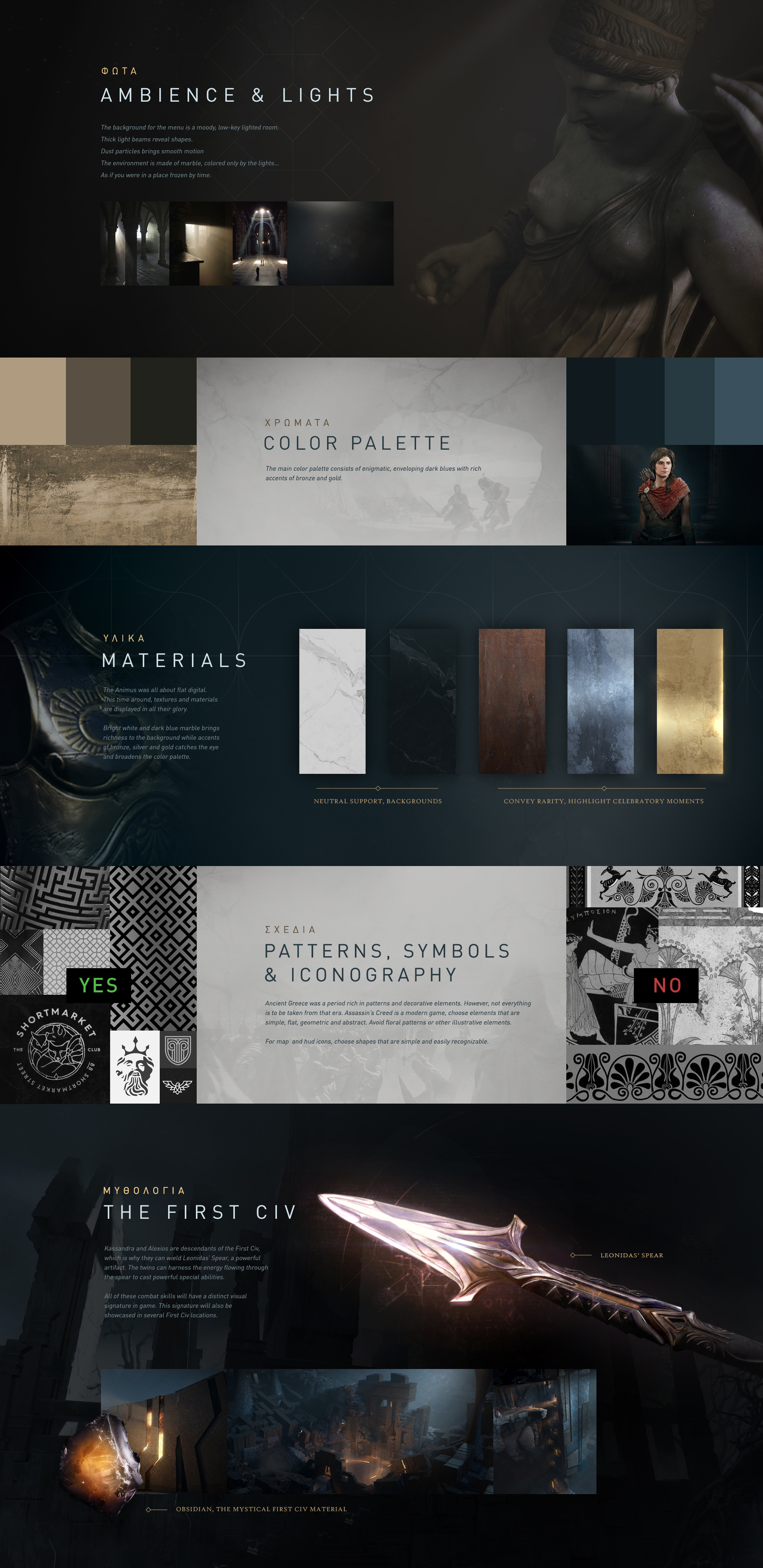
What is the favorite part of your job and what is the hardest part of your job?
My favorite part of the job is without hesitation witnessing the creative energy that radiates from hundreds of devs working together towards a common goal. Prior to joining the industry, I used to have a very narrow-minded opinion of what made great games, thinking that individual talent is what created masterpieces. I now realize that building a strong team is what matters most, and that without collaboration, you can’t steer a ship this big.
On top of that, I find UI challenges to be extremely stimulating; we have to take the team’s goals for what they want the player to feel, and we’re responsible for presenting it in a digestible and delightful form. When you stop and think about it, the UI is the narrator for the game. I love that connection.
As for the hardest part of my job, it must come down to the iterative nature of game development. Shipping a game UI is like trying to land a plane while it’s being built. Any small change in design can have extreme consequences on the way the user interface is presented and since the whole game experience comes together very late in production, not only do we have to stay actively informed on all current and future design intentions but our UI solutions also have to stay flexible to account for possible future modifications. Through the years however, we have found ways to mitigate risks and avoid costly redesigns later in production. For example, keeping a very fluid feedback loop between the Game Design and UI team is extremely valuable. Being the ones responsible for communicating to the player through the interface, we generally have a pretty good flair for when a feature is getting overly complex, and coming up with streamlined solutions is part of our craft. This dynamic is precisely why, in my opinion, UX is getting a lot of traction over the past few years. By having people solely dedicated to the player experience, bridging the gap between the Game Design and UI teams, we can anticipate problems and develop solutions more efficiently.
What do you do when you get stuck?
First of all, getting an art block is something that will happen several times over the course of a AAA project and it is a part of the creative process you need to be at peace with it. Most of the times when I get stuck, it’s because I have tunnel-vision. After working for a while on the same thing, you start to lose perspective and it’s easy to doubt some of the choices you made along the way. One of the things I’ve learned through the years to minimize the risks of falling down this spiral is to slowly figure out each piece of the puzzle at the same time, rather than relentlessly trying to polish a single component until you are ready to call it finished. Things are bound to change. Design will evolve, new ideas will pop and visual language from one element might carry over to another one seamlessly. This isn’t to say that having a “beautiful corner” isn’t important, but working on as many things as possible at the same time in an iterative manner gives me the option to switch my focus to another task until I feel confident enough in my strategy to bounce back into it.
Can you expand on that “beautiful corner”?
Ha ah! Of course, everyone wants to live in the beautiful corner! Basically, one of my main responsibilities as a director is to communicate a strong vision to my team and partners. Ultimately, they are going to be the ones materializing this vision in game, but first I have to provide them with clear guidelines and references. What really helps is having a few pieces of the UI that represent the intention for the final level of quality and polish that all other pieces will aspire to match as they develop. I usually choose very important and complex features for this to make sure I tackle as many hurdles as possible (the HUD and an inventory management page are always good contenders). Even if I know that most of the design ideas will evolve significantly during production and that a lot of use cases are still to be figured out, I can already answer a lot of important questions here. How do buttons behave when you hover them? What are the text-casing rules? Should the icons look flat or textured? What does a celebratory “Level Up” event look like in-game? I spend a lot of time polishing these shiny pieces and often use them as conversation starters. I’ll even create new ones along the way if it helps me make a wild idea get greenlighted!

Assassin’s Creed Odyssey’s Inventory page
Of all the projects you/your company have produced, which one are you the proudest of?
The notion of pride in my craft really manifests itself over two dimensions. First off, there is the sheer amount of fulfilling moments sprinkled over the course of a game’s development. Most of them happen when several people come together to solve complex problems that would be insurmountable as an individual. Additionally, there’s a lot of gratification I feel at a human level, through the connections and trust I keep nurturing over the years with other team members – that means a lot to me intrinsically.
On the other hand, there’s this weird relation I have with personal satisfaction where it always takes a few months, even years to fully appreciate a project I have shipped and call myself proud of it. Given how challenging game development is, finally putting your heart and soul into the hands of players is exhilarating, but also very stressful. We spend so long exposed to the same ideas over such a long time that our opinion on it is greatly distorted, usually in a deceptive way. And even if positive feedback should feel very comforting at this culminating moment, it’s like no amount of praise can fill the giant void left by this weight being taken off our back. On a positive note, although it might take a while to get the proper closure, I’ll eventually look back at almost any project after a few years and go: “Yeah, this one was special!”.
Do you have any advice you wish you’d received when getting started?
This is such a difficult question, because things have changed a lot over the 15 years since I started, but there is one advice that I do feel is timeless. It’s something that I still work on myself every single day, and that’s to remember that you are shipping THE game, not your game! I used to have this very individualistic vision of game development where I believed if you gathered the most talented individuals and gave them total creative freedom, naturally the best game would emerge. The reality is that you can’t have a team of “alpha” types, it just doesn’t work. You absolutely need to cultivate a team mentality. By empowering and inspiring others, not only are you making a better work environment, but also a better game. Look at problems from multiple perspectives, actively listen to others, compliment their work. The projects you work on will change every few years, but your team (and reputation) will stay.

Part of my responsibilities is to make sure external assets, such as posters or art books also align with the in-game visual identity.
What’s your point of view on the future of gaming?
Ok so, once again, I see this from two perspectives. First, you must know that I’m an incredibly nostalgic person. If you ask me about my lifetime top 10 games list, probably 8 or 9 of them are Super Nintendo titles from my teenage years. When I sit down to play games, I really just want to be transported back to my parent’s basement 25 years ago, sitting in front of the 20-inch CRT on that comfy, shaggy rug. Technology obviously has evolved a lot over the years but my expectations towards games as an entertainment medium have not. So, in regard to my point of view on the future, as long as we keep creating fun and accessible experiences, I believe there will always be players interested.
That being said, there is one niche I’d love to see expand and its games with real world benefits. We already have some incredible examples in titles such as Ring Fit Adventure, which is essentially a fun fitness session, or Assassin’s Creed Origin and Odyssey Discovery Modes, both interactive and immersive history lessons. I really like the idea of expanding our medium to create experiences that are not only entertaining, but also enhance the lives of players!

